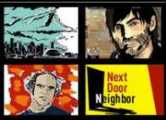EXCERPT: Welcome to Shirley by Kelly McMasters
Sunday, May 11th, 2008
On the surface, Kelly McMasters had a perfect  American childhood: A kind family, supportive neighbors, sparklers on the Fourth of July, sledding expeditions in the woods, popsicles made in ice cube trays. But as she grew older, she started to notice that things in Shirley, a working class Long Island town, were not what she’d thought. From the town’s protracted struggle to change its image to the growing presence of the nearby nuclear research facility, Shirley is a troubled place that can’t seem to catch a break. In these excerpts from her memoir Welcome to Shirley, McMasters discusses this growing realization and how she had to learn to reconcile her childhood memories with her adult knowledge. (read an interview here) —Elizabeth Minkel
American childhood: A kind family, supportive neighbors, sparklers on the Fourth of July, sledding expeditions in the woods, popsicles made in ice cube trays. But as she grew older, she started to notice that things in Shirley, a working class Long Island town, were not what she’d thought. From the town’s protracted struggle to change its image to the growing presence of the nearby nuclear research facility, Shirley is a troubled place that can’t seem to catch a break. In these excerpts from her memoir Welcome to Shirley, McMasters discusses this growing realization and how she had to learn to reconcile her childhood memories with her adult knowledge. (read an interview here) —Elizabeth Minkel
From Chapter 4:
When looking at Long Island on a map, I’ve always seen an alligator. I know most people refer to the island as being shaped like a fish—in school I learned that the Native American Indians had in fact named the place Paumanok, or fish-shaped island—but the east end of the 118-mile strip gets muddled in that description. What kind of fish really has a tail that forked so dramatically that it could stand in for the thin slip of Montauk? To me, Long Island looks like an alligator facing away from the continent, his tail curled up along the side of his body. He is yawning out into the Atlantic Ocean, Gardiner’s Island dancing like a shrimp above his elongated lower jaw, mouth about to snap shut on its prey. Shirley is located at the spot where the upper and lower jawbones connect, just beneath his chin.
As the weeks turned into months, and we became more entrenched in our new home, I became more and more fascinated by Long Island. Since my father was at the golf course most days, my parents bought a second car—Jerry’s brother’s scrappy green Concord—so my mother could run errands without relying on her husband’s erratic schedule. My mother took me on short drives, and I was soon able to distinguish routes and roads, and where we were on different road maps. I would trace the branching highway lines along the middle of the island, calculating the miles between our town and New York City, which felt as far away as, say, Kentucky, or even London. At the time, I could’ve cared less anyway; I was content to spend my time outlining our craggy little area on the Hagstrom maps my father pored over at night for his new job, searching for back roads and alternate routes to get to his clients faster. I quickly learned to identify Shirley by the way it sticks out of the island’s south shoreline like a bucked tooth, as if the rest of the island is shying away from the town.
I always liked coming back to Shirley if my mother’s errands took us away from the town, and I still do. Driving along the Long Island Expressway back home, the commercial strips and black tar parking lots and towering street lamps dotting the sides of the highway fall away. The gully dividing the lines of traffic grows from a mere strip of concrete to a wide swath of field where deer lazily feed, ignoring the cars whizzing past. The pines are tall and scraggly, like teenage boys growing too fast for their clothes to keep up, awkward skinny limbs sprouting out at odd angles. There are signs along the highway in this area that announce these trees as part of the Pine Barrens, one of the largest protected pine forests on the East Coast. In the midst of these Pine Barrens is exit 68, where the name Shirley is stenciled across the dark green of a highway sign in white day-glo lettering. A second, smaller sign notes that exit 68 is also the turn-off for the Brookhaven National Laboratory. This sounded very official and, since I never saw it because the Laboratory was hidden under a thick cover of trees, it felt as far away as Manhattan, even though it shared an exit with my town.
In the summertime, my mother would click her right blinker on and get off at exit 68 with about half of the other cars on the Long Island Expressway. We would travel with the pack southwards down the William Floyd Parkway until we hit the sunburnt-orange Roy Rogers and squat white church with giant black letters spelling out Jesus is Lord across the back of its building. Here, the majority of cars made a left turn, following signs for the Sunrise Highway, the road that would take them the rest of the way to the Hamptons at the east end of Long Island. For most people, the spot was simply a bypass, or shortcut - an easy place to switch from one highway to another. Our small square Concord, however, would continue straight with the few cars that were left, and my mother and I would drive on into the heart of Shirley.
From Chapter 6:
The stigma of living in Shirley was especially difficult for me to understand because it was the best place I had ever lived. And as far as I could tell, everyone in my neighborhood agreed. At the time, I didn’t understand, or rather, it never occurred to me that my family—or the other families in Shirley—didn’t have a lot of money. My friends and I only had one another with which to compare ourselves.
Playing outside in the Wildlife Refuge, the honeysuckle stems that we spent hours sucking on tasted as sweet for us as for anyone else, and the trees rustled and whispered to us in the same soft voices, too. The magnolia tree on Melissa’s front lawn bloomed as heartily and the waves of the ocean crashed as thunderously for our small group of scraggly girls as for any others. I had not yet been denied something I needed because we didn’t have enough money, and, unlike my parents, I had not yet been denied entrance or acceptance because of where I lived.
For the longest time, I thought the yellow flame that glowed from far away on top of this small mountain we drove past on the Long Island Expressway was the Statue of Liberty. I would smile secretly at the bright spot from the backseat of our car, a star of fire on the horizon.
Years later, I realized that what I took for the Lady’s torch was actually an incinerator, and the small mountain was a landfill. It was in this way that I woke to the reality of Shirley within the span of a few years.
Reprinted from Welcome to Shirley by Kelly McMasters, by arrangement with PublicAffairs (www.publicaffairsbooks.com), a member of the Perseus Books Group. Copyright © 2008.






I am sure that on https://topspyingapps.com/how-to-find-the-owner-of-a-phone-number/ you will learn how to find the owner of a phone number. It’s really useful to know
Amazingness will transform the way you live and also work .
I am so happy to have you in my life. Your willpower is inspiring!
The top quality of your content is just outstanding!